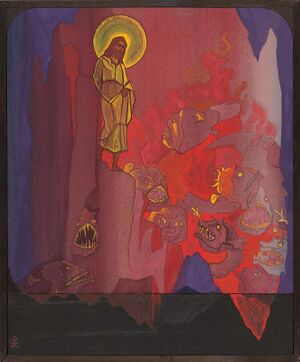Jesus' descent into hell

It is a Christian belief that between his crucifixion and resurrection Jesus descended into hell, where he preached and brought salvation to souls imprisoned there. Christian tradition states that this was not “hell” as the state of eternal punishment for sin but a realm where all the dead abided.
Christian theology
The tradition of Jesus’ triumphant descent into hell, also called the “harrowing of hell,” became a part of the Church’s theology as affirmed in the Apostles’ Creed, the statement of the fundamental tenets of Christian belief that in its earliest form can be traced back to the second century. The Roman Catholic version of the creed states that Jesus “was crucified, died, and was buried. He descended into hell; the third day he arose again from the dead.” I Pet. 3:19 states that Christ “preached unto the spirits in prison.”
In his exegesis on this verse in The Interpreter’s Bible, Achibald M. Hunter points out that
Exegetes have differed about the interpretation of every word.... The simplest meaning is that our Lord descended between his passion and resurrection, to preach to certain spirits imprisoned in Hades.... But who were the imprisoned spirits? Just possibly the fallen angels of Gen. 6:1–4. Much more probably Peter meant the spirits of the rebellious generation who perished in the Flood.
Hunter says that the early Christians may also have been concerned about
... the fate of those who had died before the gospel was preached.... Christ went down “in the spirit,” says Peter, into Hades,... in order to offer salvation to sinners who had died without hearing the gospel and getting a chance to repent.... In the apocryphal Gospel According to St. Peter (ca. A.D. 130), among the wonders attending the Crucifixion we read the question, “Hast thou preached to those who have fallen asleep?” To which the answer was heard from the Cross, “Yes.” And in the Middle Ages the harrowing of hell was a common theme in popular poetry and theology.[1]

The Ascended Master Jesus’ account of this event
In a dictation delivered on Easter Sunday, April 6, 1969, through the Messenger Mark L. Prophet, Jesus said he had come to exhort us with the same sermon he had preached to
... the rebellious spirits that in the days of Noah were disobedient unto God.... I preached and repreached and spoke again and again to each soul that I could find there who was in chains of bondage and despair. Many gazed upon me with dullness in their eyes, the dullness of despair, the centuries of timeworn care and fear and doubt. The very light of God seemed to them [to be] put out and I sought to rekindle it then as I do today to rekindle it in you God’s way.
A requirement for all who would ascend
In a dictation on June 19, 1975, Saint Germain spoke about the calling of Keepers of the Flame to be a part of this continuing mission to reach souls caught in the astral plane:
When you determine to be a world server with Jesus, with Nada, with Uriel and Aurora, take heed. For you serve at the point where mankind create turbulence and turmoil and dark rhythms.
This is why Jesus descended into the astral plane in order to preach to these lower forms of life. This is not only the requirement of those who ascend (because it is a requirement of passing through the sixth ray), but it is the mark of the Piscean conqueror. And this is what you shall be—sons and daughters of dominion of the water element bearing the cross of Christ, bearing that cross in that solar-plexus chakra, destined to be the purple and gold of the Elohim.
Thus every thrust of fire, every momentum of victory in the heart rises to the throat for release in the sacred Word and then descends to the solar plexus to turn back the tides of darkness. This is the momentum that you have generated by your devotion. This is the momentum you must keep. This is the mystery that I show you and that I show the saints ascended and those in the etheric plane serving on the sixth ray, who are taking their initiations.
These souls carry torches, and they descend wearing robes of white. They pass through a dark tunnel, one which would remind you of the catacombs where the early Christians fled, where all is night and blackness. It is a dark tunnel, as though it goes into the very bowels of the earth. These souls descend carrying the flame that you have invoked, the flame of ministration and service. They are allowed to descend into the astral plane because you hold the balance and the fulcrum in the physical plane through your decrees and invocations.
And why do they descend into the astral plane and why do they carry torches? Not only do they do so to light their way, but they use the torches to find the children of God who are lost in these caverns, in these caves that are wet and dark—children of God who have been lost between embodiments, lost for hundreds of years who were taken there as in the worst horror movies that you could imagine, far beyond those that have been created upon earth.
These are souls of light, children of light who have been kidnapped by the fallen ones, and it is the ministration of the Christed ones to descend deeper and deeper into the astral plane in order to rescue the children of light, to draw them up again into the light of day and into the dawn of the Christ and the victory of the Mother. So these Christed ones are going forth into the astral plane this night because you have cared enough to keep the flame.[2]
See also
Sources
Pearls of Wisdom, vol. 32, no. 23, June 4, 1989.
